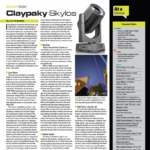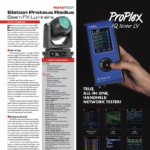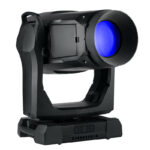Vaddio has been around for more than 10 years now, supplying the world with robotic cameras. Yesterday I made a trip out to their Minnetonka, MN office space to find a pretty massive office and warehouse where the employees numbered over a hundred. Everything made by the company is built in America, assembled right here at their sparkling clean facility. That was just the first thing to impress me.
Last November, Vaddio released their latest line in PTZ robotic cameras and control systems with the RoboSHOT. They have big plans for these models, and if the first two I played with yesterday are any indication, Vaddio’s dominance in their field will continue. The RoboSHOT 12 and 30 are the two high-definition PTZ models I am looking at today, and the first thing I notice is they are small. Visually, they appear to be half the size of most robocams on the market. They are mounted to some studs in the wall via a thin profile wall mount, which the camera attaches via a single bolt. There is an anti-vibration mount device available. Of course, any clamp can be easily modified to attach these cameras to a truss.
Setting the Bar High
Vaddio has revolutionized the robotic camera world by releasing its first cameras that utilize their Tri-Synchronous Motion feature. Let me explain this.
PTZ stands for pan, tilt and zoom. These are the three attributes that are utilized in the RoboSHOT series. Through the use of this new technology, this series of cameras can pan, tilt and zoom simultaneously as the camera switches from one focus area to another. Say the camera is pointed at a choir director one minute, but at a point of the show it needs to move 20 feet upstage to a choir member singing a solo. The camera will sweep to the new destination in any set time and automatically adjust its zoom and focus while moving. This way, by the time the camera gets to it’s new destination, it is in focus with the intended object/person it is picking up. The RoboSHOT is the only robotic camera that can claim these bragging rights.
The decision on which camera one would use depends on the application. Having two to play with simultaneously, I am able to note distinct differences besides their exterior colors. The 12x and 30x in the models stand for different optical modes. The RoboSHOT 30 (available in black or white) is best suited for a big room. If you are planning on picking up objects and people in a large room, this is no problem. The 30 can zoom down to 2.3° and pick up a nametag on a person from 60 feet away. It can then zoom wide to a respectable 63°. The 30 just may be the perfect camera for placing at the back of the house in any corporate meeting, whether to augment or even replace an actual cameraman. This beauty can pick up a speaker at a podium one moment, then quickly pull out to a wide shot capturing the audience as they stand and applaud.
The RoboSHOT 12 (available in silver) is more suitable to the boardroom or small application. It can pick up a single person’s head sitting in a chair, then zoom out to 73° to pick up the whole conference table.
I placed a water bottle on a shelf approximately 15 feet away from each camera and zoomed in close with each one. I notice the difference in zoom between the two cameras as the 30x model can effortlessly pick up the small writing on the bottle while the 12x can only read the name on the label. The completely silent, brushless motors in the camera can move it at variable and preprogrammed speeds. No matter what speed I choose, it functions with a smooth movement and no jittering whatsoever. This is perfect for broadcast applications. And, of course, by the time the camera gets to its next destination, it is perfectly in focus.
The Magic
The lens, image sensor and ISP (image signal processor) are behind this camera’s awesome video characteristics. The lens is made of multi-element glass and is scratch resistant. An image sensor is built into the camera to capture the light from the optics (lenses) and converts it into an electronic signal, which represents the image. The quality of the image sensor has a dramatic impact on the color and quality of the image. The actual image sensor Vaddio uses is the latest generation Exmor 1/2.8-inch, 2.34 megapixel, full HD (1080p/60) high-speed, low-noise CMOS model. By combining this with the new ISP the camera produces vivid, accurate color along with razor sharp clarity focus.
The RoboSHOT utilizes the Vaddio EZCamera System to deliver the HSDS differential video signal and power. To control the other functions such as pan/tilt, zoom, color and iris, the camera utilizes an RS232 connector. When one looks at the back of the cameras they will notice that this is all done via CAT-5E or better cables. These cameras come equipped with Ethernet connectors and have a built in web browser, which makes it convenient for control. The cables come back to one of Vaddio’s five various models of Quick-Connect interfaces.
Taking Control
Perhaps the easiest way to control this camera just may be through your PC tablet or smart phone. Anyone with a decent Internet signal can control the camera’s functions on a web browser. There is no program to download, you simply log on and register the individual IP address of the camera(s) to the webpage with any browser. Firefox, Safari, Chrome, and Internet Explorer are just some of the proven web browsers that work with these cameras. It is incredibly easy to run, and takes about a minute to figure out. The cameras come equipped with an IR Sensor and ship with a handheld remote device. This remote can easily control the PTZ functions.
Of course, the cameras can be connected to one of control systems. I tried the ProductionVIEW HD MV Joystick controller, which allowed me to effortlessly focus the camera on a position. The same stick has a zoom knob on it to tighten up my zoom as the cameras auto-focuses on the object. One can record up to 12 preset positions (per camera) that will remember your PTZ locations, on the controller. The camera itself has 16 internal presets with presets 13-16 available through third-party control systems such as Creston, Extron or AMX. There is a speed knob that will also adjust the time you want the camera to move from point A to point B. Perfect for corporate meetings where one would like to use a camera to sweep between the speaker and the graphics he is presenting during a slide show.
The RoboSHOT has a lot of compatibility interfacing with a lot of other systems. While maintaining an aspect ratio of 16×9, there are nine different supported resolutions from 0 through F, including 1080p/30, 1080p/60, and so on. There is a standby mode that essentially puts the camera to sleep when not in operation. There are different presets one can use to shade the cameras for different lighting applications at a venue. These can be set to automatic, and there are also settings for incandescent, fluorescent, and outdoor modes. When using the RoboSHOT with Quick-Connect Universal CCU there are individual HD-SDI, HDMI and analog YPbPr outputs, all of which can be used simultaneously.
Whether in a house of worship, a corporate meeting or even a concert environment the RoboSHOTs are at the top of the line in performance.
At a Glance
Smooth Operators
There are small differences between the two compact RoboSHOT cameras I tried — the RoboSHOT 12 and 30 — that go beyond their exterior color (silver and black or white). The 30x model can pick up the small writing on a water bottle placed 15 feet away; the 12x could only read the name on the label. But their many other qualities combine to make these PTZ models well suited for a wide array of live events. —N.S.
Vaddio RoboSHOT 12 and 30
PROS: Tri-Synchronous™ Motion, smooth and silent motors, Image Sensor, razor sharp clarity and color, built in web server.
CONS: None
MSRP: P12: $4,595 to $5,795, depending on the control system
P30: $5,795 to $6,995, depending on the control system
More Info: www.vaddio.com

For a video of the Vaddio RoboShot in action, go to www.plsn.me/VaddioRobo



